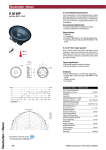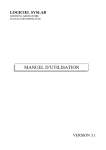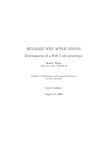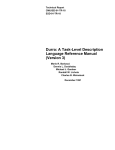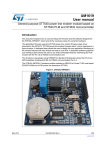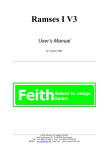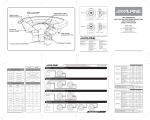Download A Preliminary Report on xMECH 1 Introduction
Transcript
A Preliminary Report on xMECH
A. Azurat and I.S.W.B. Prasetya
Institute of Information and Computing Sciences
Utrecht University
P.O.Box 80.089
3508 TB Utrecht
The Netherlands
{ade,wishnu}@cs.uu.nl
Abstract
This document reports the current development status of xMECH. It is
an implementation of the so-called skin or hybrid embedding approach [1] for
HOL. Its purpose is to enhance HOL’s power and interaction to do software
verification. xMECH features languages and logics to describe and verify
sequential and distributed programs, a reasonably rich expression language
to write specifications, and optimized verification condition generators. It
is available for public use, but it is still in a prototype phase, with limited
features and user support. It comes with some simple demos, but doing a
serious project with xMECH is not (yet) recommended for an inexperienced
user.
1
Introduction
Despite the advance of computer aided technology, mechanical verification of realistic programs remains a challenge. Many programs are parameterized by unbounded
constants, or require sophisticated data structures to specify. These are things that
put them beyond the reach of even the most sophisticated model checkers. There
are powerful mechanized logics such as HOL that can deal with infinite and sophisticated data structures, but they pose another restriction, namely that the actual
programming logic we want to use has first to be embedded into them. Embedding,
however, has its own problems (e.g. problems with readability and problems with
embedded type system) [1] and are labour intensive.
1.1
The xMECH Concept
In the multimedia world, a skin is a program that runs on top of a primary application to change the outer look of the primary application. This is a good analogy
for xMECH, which is a skin for a well established general purpose verification tool
called HOL. However, the purpose of xMECH is not to give HOL a different physical look, but to give it various adds-on verification devices to make verification with
HOL more convenient.
xMECH is built around HOL, thus giving xMECH user access to HOL’s features:
1. HOL is based on a familiar logic (predicate logic).
2. HOL logic is higher order, so it is very expressive. It can easily express infinite
state spaces and sophisticated data structures.
3. HOL has a rich collection of mathematical theories and proof tools.
4. HOL comes with a powerful proof scripting language (ML).
1
To circumvent problems encountered in (pure) embedding, xMECHuses an approach called Hybrid Embedding[1]. The approach has a more pragmatic view towards mechanical verification. So, parts of pure embedding which are problematic
are simply not embedded. Instead, they are directly implemented. We implement
them in ML, because it will make interfacing with HOL much easier, since HOL is
also written in ML. Because some parts of the proof machinery are not embedded,
xMECH cannot provide unbroken correctness guarantee to proofs the way HOL
does [3]. In exchange, it strives to provide an environment that facilitates rapid
composition of proofs of realistic programs.
1.2
Features
To express programs and their properties xMECH offers a number of programming
and specification languages, built stratifiedly, together with some logics to reason
about them:
1. EXPR: a quite rich language of expressions used to specify (the set of) possible
states a program can be in a given moment. Currently, it has functions, tuples,
arrays, and lists. The type system is simple but for many purposes sufficient,
allowing polymorphism and higher order functions.
2. PLSEQ: a programming language and logic for sequential programs. Programs are specified using Hoare triples. PLSEQ uses EXPR to specify preand postconditions, so it is quite expressive in what it can specify.
3. PLGA: a programming language and logic of guarded actions. Guarded actions models concurrent actions. PLGA has lots of PROMELA1 flavour in it.
Programs are specified using UNITY temporal operators. The logic of PLGA
is UNITY logic [2], which we favour because of its simplicity and its high level
axiomatic style.
As said, xMECH is a ’skin’ built around HOL. The core semantics of the logics
used by PLGA is embedded in HOL. The syntactic parts (grammars, parsers, and
pretty printers) of the above languages provided by xMECH and their semantic
functions (to translate to the HOL semantics) are part of the skin, and hence they
are not embedded. In addition, the skin also provides utilities such as:
1. Type checking.
2. A verification condition generator for sequential programs (PLSEQ) specifications (based on wp calculation).
3. Some simplification algorithms, such as an algorithm to a DNF normalization on a formula and an algorithm to, given a PLGA program, remove as
many actions as possible, which at a specified ’duration’ during the program’s
executions are disabled (so these actions do not actually take part in the
computation and hence can be safely removed).
1.3
Download
xMECH prototype is publicly available at www.cs.uu.nl/~ade/xmech.
1 PROMELA
is the input language for SPIN model checker. See [5]
2
PLGA is intended
to be intermediate. It is the core
of PLPC, a programming language
and logic of process classes, which
is currently still unfinished. The language of PLPC extends PLGA with
sections to define
the structure of a
distributed system
and the interface of
the system to its
environment. The
logic of PLPC is
based on an extension of UNITY
that includes necessary laws to deal
with program composition [7].
expr
→
|
|
|
|
|
|
|
|
|
program-variable
literal
pair
concrete-list
function-application
array-access-expression
expr infix expr
existential-quantification
universal-quantification
( expr )
Figure 1: The general syntax of EXPR
1.4
Using xMECH
Basically xMECH is working alongside with the HOL environment. Just like HOL,
all instructions are executed interactively. A program and its specification is read
by xMECH. In principle, once read, a specification can be manipulated interactively
in xMECH. Currently we only provide a very limited form of xMECH interaction.
We hope to provide more interactive transformation commands in future versions –
until then a power user should program his own commands. In the current version,
the user can only call the verification condition generator for either PLSEQ or
PLGA. This will analyze the specification, apply some simplification algorithms,
and generate EXPR level verification conditions. The latter are then translated
to HOL and set as a HOL goal. From that point on the user will enter the HOL
environment and finish the proof in HOL. Consequently, the user should already be
familiar with the use of HOL.
In Sections 4 and 5, we will show examples of PLSEQ and PLGA specifications
and the corresponding xMECH sessions –complete input files containing those examples and their proof script files can be found in the xMECH distribution.
2
EXPR
Unlike other tools, e.g. Spin or STeP, xMECH comes with a quite expressive language of expressions called EXPR. In a programming language, an expressions is
typically used at the right hand side of assignment and as a guard of a conditional
or a loop. Since xMECH is a verification tool, it also allows us to specify the properties of a program. EXPR is also used in specifications, for example to specify
the pre- and post- condition of a sequential program. It is polymorphic and higher
order. Using it, we can express quite complicated specifications. Note that the program being specified itself does not need to be polymorphic or higher order. It may
however implement a property that requires a sophisticated expression language to
describe.
The general syntax of EXPR is shown in Figure 1.
• Boolean literals are T and F. Integer literals are, e.g., 1, 0, and -1. A string
literal is written in quote, e.g. "hello".
• An empty list is written -[]-. A concrete non-empty list is written, e.g., like
-[a,b,c]-. Lists can be nested.
• A tuple is written, e.g., like (x,y,z). Tuples can be nested.
• An array expression a#n returns the n-th element of the array a.
3
EXPR is represented by a data
structure which is
more abstract than
the λ calculus representation chosen
by, for example,
HOL. This makes,
the programming
of syntax driven
analyses
and
transformations on
EXPR
sentences
considerably easier.
Some of the syntax of EXPR is
awkward,
such
as function application and array
access –we do not
have time yet to
polish the syntax,
but this should be
fixed in the future.
A similar remark
holds for PLSEQ
and PLGA.
• A function application is written, e.g., like f>>x. In PLGA/PLPC we can also
write it as (f x).
• An existential quantification is written, e.g. like:
(?i,j: 0<i /\ 0<j : i=j)
A universal quantification is written in the same way, except that ! is used
instead of ?.
• Table 2 lists the binary operators (infixes) that currently are recognized in
EXPR. Some of the less common are, e.g.: x::s (the list consisting of x as
the head and s as the tail); s!!i (the i-th element of the list s; s++t (the list
t appended to s).
• A meta identifier is a constant that is not part of the program being specified
by xMECH. Typically, this is a function such as the length function that
returns the length of a list. The prefixes in Table 2 are the meta identifier
currently known to EXPR.
When parsing a program (PLSEQ, PLGA, or PLPC), an identifier which does
not appear in the list of known meta identifiers will be looked upon by xMECH
as a program variable.
2.1
Expanding EXPR
One can extend EXPR by adding new meta identifiers, for example, more list functions. It is important to realize that EXPR is just a language interface. So it does
not care about the meaning of an expression, though it still needs to know, for
example, the names of the meta identifiers. When xMECH needs to prove that
a given expression asserts truth, it will send the expression to HOL and ask you
to prove it there. In particular, HOL should know the meaning of all your meta
identifiers. Therefore, when you add a new meta identifier to EXPR, make sure its
meaning is already defined in HOL.
The file exConst.sml specifies the list of meta identifiers known to xMECH. To
add a new meta identifier, you add a new entry in the list specifying the name of
the meta identifier, its type, and its translation to HOL.
New infixes cannot currently be added without hacking into xMECHparsers.
3
TYPE
An expression (a sentence from EXPR) must be well typed. xMECH has a simple
type system called TYPE which basically is similar to that of HOL. It supports
polymorphism. TYPE has three primitive types: bool, int, and string. A type
variable is written as any alpha-numeric sequence which is the name of a primitive
type. It must start with a roman character. So, e.g., a or ab or a1 can be used as
type variables.
The following type constructors are available. The notations used by PLSEQ
and PLGA differ slightly.
PLSEQ
a->b
[a]
[]a
a#b#c
PLGA/PLPC
a->b
a list
a[n]
a#b#c
meaning
function from a to b
list over a
array over a (in PLPC: of size n.)
the product type of a, b, and c
4
EXPR
basically
allows expansion,
but currently we
have no support
to do this conveniently.
Not
recommended for
an
inexperienced
user.
It seems possible,
by exploiting ML
functor mechanism,
to provide multiple
type systems and to
let the user chooses
one at the run time.
symbol
true
false
=
\/
/\
==>
~
?
!
<
<=
>
>=
=
+
*
^
/
mod
div
-[]hd
tl
::
#
++
elem
map
filter
concat
length
type (in PLSEQ notation)
bool
bool
a → a → bool
bool → bool → bool
bool → bool → bool
bool → bool → bool
bool → bool → bool
string → bool → bool → bool
string → bool → bool → bool
a → a → bool
a → a → bool
a → a → bool
a → a → bool
a → a → bool
a→a→a
a→a→a
a → int → a
a→a→a
int → int → int
int → int → int
[a]
[a] → a
[a] → [a]
a → [a] → [a]
[a] → int → a
[a] → [a] → [a]
a → [a] → bool
(a→ b)→ [a] → [b]
(a→ bool) → [a] → [a]
[[a]] → [a]
[a] → int
fixity
constant
constant
infix
infix
infix
infix
prefix
prefix
prefix
infix
infix
infix
infix
infix
infix
infix
infix
infix
infix
infix
constant
prefix
prefix
infix
infix
infix
prefix
prefix
prefix
prefix
prefix
Table 1: Predefined Symbols in EXPR
5
These are the types supported by xMECH parsers. The representation of TYPE
actually allows arbitrary type primitives and constructors:
datatype Type
=
|
TyVar of string
TyCons of string * Type list
TyVar a represents a type variable called a and, for example, TyCons "list" t
represents the type of list of t.
By constructing the representation directly the user can construct any type
allowed by the representation. Since in verification expressions are sent to HOL,
each type being used in the expressions must be a valid HOL type.
xMECH currently does not support in-line type information. So we cannot write
something like ((x:int) = y) ==> b as in ML and HOL. However, it has a type
inference system, so you can write x>0 and xMECH will recognize x as a program
variable of type int.
When a PLPC program P is parsed, a type context for P is constructed. It
lists the variables of P and their types. This context is needed by xMECH to type
check P and its specifications. PLSEQ and PLGA do not currently have declaration
sections, therefore, the user will have to construct the type context by hand, see
Example 4.2:
4
PLSEQ
PLSEQ stands for Programming Language and logic for SEQuential programs. Currently, it is still a very simple language. It has sequential composition, conditionals,
and loops. PLSEQ is originally intended to be used to specify actions in PLGA,
but we can also use PLSEQ add-ons as a stand-alone environment for verifying
PLSEQ programs. Supports for stand-alone use of PLSEQ is however still rather
primitive, so some programmings to set up the environment is needed. This should
be improved in the public release.
PLSEQ commands looks very much to C commands, though it allows a much
richer expression language (EXPR). A rich expression language is needed to formulate a program’s specification. Any EXPR sentence can also be used in the program
itself, e.g. as guards of conditionals and as the right hand side of assignments. It
means that PLSEQ programs can also be very abstract, and hence are also suitable
to describe abstract models.
The types supported by PLSEQ are the same as the types of TYPE.
PLSEQ also supports array. Currently, only unbounded integer indexed arrays
are supported. Accessing the n-th element of an array a is written as a#n.
4.1
Program
Here is a simple PLSEQ program to search for an integer 0 in an array of N integers.
It sets a boolean variable b to T if the search is successful, otherwise b is set to F.
The program exits its loop as soon as a 0 is found.
Code 4.1 : Linear Search with Break
{ n=0
b=F
while (~b /\ ~(n=N))
if (a#n=0) b=T
}
;
;
else n=n+1
2
6
;
No assignment to
an array element
is currently supported. Note that
this will require the
logic to be extended
with rules to reason
about aliasing.
1. The wps:
wp
wp
wp
wp
wp
(x := E) Q
(if g then A else B) Q
(inv I while ( g ) A) Q
{ } Q
{A;B}Q
=
=
=
=
=
Q[E/x]
(g ⇒ wp A Q) ∧ (¬g ⇒ wp B Q)
I
Q
wp A (wp { B } Q)
2. The inference rules:
(a) For all PLSEQ statement A except loops we have:
[P ⇒ wp A Q]
{P } A {Q}
(b) For the while loop we have:
[P ⇒ wp (inv I while ( g ) A) Q]
{I ∧ g} A {I}
[I ∧ ¬g ⇒ Q]
{P } inv I while ( g ) A {Q}
Figure 2: PLSEQ inference rules
Note that ; is used as a terminator, not a separator.
See Appendix A for more language constructs supported by PLSEQ.
Currently PLSEQ supports no declaration part to specify the names and types
of the variables of a program. These have to be specified by hand, e.g. as follow:
Code 4.2 : Context Declaration
val varContext_ofDemoProgram =
let
val p = TypePara.parseInLine ;
in
[("b",
p "bool") ,
("n",
p "int") ,
("N",
p "int") ,
("a",
p "[]int" )]
end
2
4.2
Logic
PLSEQ logic is a simple Hoare logic. Currently, only partial correctness [4] is
supported. PLSEQ inference rules are shown in Figure 2. If the program contains
loops, xMECH requires the user to specify the invariant of each loop.
4.3
Specification
The following code shows the linear search program again, but now annotated with
the pre/post-conditions specifying what the program is supposed to do. It also
specifies the invariant of the loop in the program.
Code 4.3 : Linear Search with Break –annotated code
{= 0<=N =}
{ n=0
;
7
b=F
inv
;
(! i: 0<=i /\ i < n : ~(a#i=0))
/\ 0<=n /\ n<=N
/\ (b ==> (a#n=0)) /\ (b ==> n < N)
while (~b /\ ~(n=N))
if (a#n=0) b=T
else n=n+1
;
}
{= b = (? i: 0<=i /\ i < N : a#i=0) =}
2
4.4
Verification
Annotated code such as the one above is the input of xMECH. Before reading
this input, the user must first start HOL. From HOL, execute the following ML
command to load the required xMECH-PLSEQ add-ons (or it can be put in the
script file):
Code 4.4 : PLSEQ Environment Loading
val xmech_sigobj_loc = "./";
val env_loc = "./EXAMPLES/PLGA/";
loadPath := xmech_sigobj_loc :: !loadPath ;
use (env_loc^"PLSEQ_environment.sml");
2
Now we can read the specification and verify it:
Code 4.5 : Script file for Linear Search With Break example
1
2
3
4
5
6
7
8
9
10
11
12
13
14
15
16
17
18
19
20
21
22
23
24
(*
File name : linearSearchWithBreakDemo.sml
*)
val varContext_ofDemoProgram =
let val p = TypePara.parseInLine in
[("n", p "int"), ("b", p "bool"),
("N", p "int"), ("a", p "[]int")] end ;
(* reading the program now.... *)
val theProgram = parseProgram varContext_ofDemoProgram
"linearSearchWithBreak.plseq" ;
(* generating the verification conditions *)
val generatedVCs = genVerificationConditions theProgram ;
(* Starting interactive HOL proof now ... *)
set_goal([], translate2HOL generatedVCs) ;
(* try to simplify the expression *)
e (RW_TAC std_ss [ARRAYREAD_def]
THEN TRY (UNDISCH_ALL_TAC THEN COOPER_TAC)) ;
(* results in six goals... *)
(* subgoal 1 *)
8
(0 <= N ==>
((((!i. 0 <= i /\ i < 0 ==> ~(ARRAYREAD i a = 0)) /\ 0 <= 0) /\
0 <= N) /\ (F ==> (ARRAYREAD 0 a = 0))) /\ (F ==> 0 < N)) /\
((~b /\ ~(n = N)) /\
((((!i. 0 <= i /\ i < n ==> ~(ARRAYREAD i a = 0)) /\ 0 <= n) /\
n <= N) /\ (b ==> (ARRAYREAD n a = 0))) /\ (b ==> n < N) ==>
(((ARRAYREAD n a = 0) ==>
((((!i. 0 <= i /\ i < n ==> ~(ARRAYREAD i a = 0)) /\ 0 <= n) /\
n <= N) /\ (T ==> (ARRAYREAD n a = 0))) /\ (T ==> n < N)) /\
T) /\
(~(ARRAYREAD n a = 0) /\ T ==>
((((!i. 0 <= i /\ i < n + 1 ==> ~(ARRAYREAD i a = 0)) /\
0 <= n + 1) /\ n + 1 <= N) /\
(b ==> (ARRAYREAD (n + 1) a = 0))) /\ (b ==> n + 1 < N))) /\
(~(~b /\ ~(n = N)) /\
((((!i. 0 <= i /\ i < n ==> ~(ARRAYREAD i a = 0)) /\ 0 <= n) /\
n <= N) /\ (b ==> (ARRAYREAD n a = 0))) /\ (b ==> n < N) ==>
(b = ?i. (0 <= i /\ i < N) /\ (ARRAYREAD i a = 0))) /\ T
Figure 3: Generated verification conditions of the program in Code 4.3
25
26
27
28
29
30
31
32
33
34
35
36
37
38
39
40
41
42
43
44
45
val lemma1 = COOPER_PROVE (--‘~((n:int)=N) /\ n<=N ==> n<N‘--) ;
e(PROVE_TAC [lemma1]) ;
(* subgoal 2 *)
val lemma2 = COOPER_PROVE (--‘(i:int)<n+1 = i<n \/ (i=n)‘--) ;
e(PROVE_TAC [lemma2]) ;
(* subgoal 3 *)
val lemma3 = COOPER_PROVE (--‘0<=(n:int) ==> 0 <= n+1‘--) ;
e(PROVE_TAC [lemma3]) ;
(* subgoal 4 *)
val lemma4 = COOPER_PROVE (--‘~((n:int)=N) /\ n<=N ==> n+1<=N‘--) ;
e(PROVE_TAC [lemma4]) ;
(* subgoal 5 *)
e(PROVE_TAC []) ;
(* subgoal 6 *)
val lemma6 = COOPER_PROVE (--‘~((N:int)<N)‘--) ;
e(PROVE_TAC [lemma6]) ;
2
Line 9 loads the input file. Lines 3-6 load the context of the specification. This
context is a piece of ML code specifying the names of the PLSEQ program variables
used in the loaded specification along with their types. The use of this separated
context description is temporary since we have not implemented a declaration section in PLSEQ yet. Line 13 calls a verification condition generator (VCG), resulting
in a list of EXPR formulas which are then combined as a conjunction and translated
to HOL and set as the proof goal. From this point on, the proof proceeds in HOL.
The VCG exhaustively applies the inference rules of the Hoare Logic (Figure 2).
The resulting goal in HOL is displayed in Figure 3. The goal is quite large,
but it does no longer contain any PLSEQ structure. In fact, it asserts a property
purely over the data which are the object of the original program –in this case the
data are all integers and booleans. HOL is very suitable for solving this kind of
goal. First of all though, we want to simplify it. There are in fact many trivial
9
sub-formulas which can be removed. Lines 19 from the interactive session in Code
4.5 first call HOL equational simplifier and then tries to solve the resulting new
goals with HOL’s solver for integer arithmetics (COOPER_TAC).
COOPER_TAC eliminates some sub-goals, but not all (all known decision procedures on number arithmetics are incomplete). We still have some remaining subgoals (six). We can try to write a HOL script to try to automate the remaining
proof, but in this case six sub-goals are few, and they are all also quite simple. We
simply analyze them one by one, and decide which properties of integer arithmetic
are needed to prove the goal. For example, lines 25-26 prove the first sub-goal,
which looks like this:
n < N
-----------------------------------0. ~b
1. ~(n = N)
2. !i. 0 <= i /\ i < n ==> ~(a i = 0)
3. 0 <= n
4. n <= N
5. b ==> (a n = 0)
6. b ==> n < N
7. a n = 0
The goal can be proven if the following property is a theorem in HOL:
~(n=N) /\ n<=N ==> n<N
This property is quite simple. Assumptions number 1 and number 4 assert the
above property, then call the COOPER prover to prove it, then use the resulting
theorem to prove the goal quoted above.
The trick is repeated for the other sub-goals. They are proven in lines 29-45.
The proof of each is very short, but notice that each sub-goal requires different help
theorems. If more automation is desired, from HOL we have access to ML which
serves as a powerful proof scripting language. For example, we can try to guess
a list of lemmas which would enable PROVE_TAC to finish the remaining sub-goals
after the step in lines 16. Code 4.6 shows an alternative proof script.
Code 4.6 : Alternative proof script
RW_TAC std_ss [ARRAYREAD_def]
THEN TRY (UNDISCH_ALL_TAC THEN COOPER_TAC)
THEN TRY (PROVE_TAC lemmas_selection)
2
PROVE_TAC is a first order predicate logic prover. It is quite powerful. The success
of the above tactic depends on the selection of the lemmas. For example, using
exactly the same lemmas as used in Code 4.5, the tactic will prove the initial goal
without further assistance.
5
PLGA
PLGA stands for Programming Language of Guarded Actions. It is a language
for specifying distributed systems. A PLGA program is a process in a distributed
system. A system is specified by another language called PLPC, but currently the
PLPC environment is not implemented yet. We can still use the logic of PLGA
to PLGA programs in isolation. Moreover, PLGA allows concurrent actions and
thus can be used to model a distributed system, though in a less abstract way than
PLPC would.
PLGA allows types in TYPE and uses EXPR to describe expressions.
10
5.1
Program
Like PLSEQ, it has sequential composition, conditionals, and loops, but the style
is very different. PLGA tries to be as close possible to PROMELA [5] because the
latter is an established language to describe distributed systems and is supported
by a powerful model checker called SPIN [5].
Here is a simple example of a PLGA program:
Code 5.1 :
do
:: (a>0) -> x=x+1
:: (a=0) -> atomic{x=x- 1; y=y+1;}
:: else block
od
2
This program goes into an infinite loop. If a>0, it performs the assignment x=x+1.
If a=0, it performs the sequence x=x-1; y=y+1 in a single atomic execution. If a<0,
the loop simply blocks until either of the other two conditions becomes enabled.
Since the above program does not write to a, if the loop blocks it cannot unblock
itself. However, if put in a system with other PLGA programs, some other program
may change the value of a and unblock the above loop.
5.2
Block and Exit Flags
The else block flag in the Code 5.1 means that the loop will block if no guards
are enabled. Similarly, we can put the same flag in a conditional statement:
Code 5.2 :
if
:: (a>0) -> x=x+1
:: (a=0) -> atomic{x=x- 1; y=y+1;}
:: else block
fi
2
If none of the guards are true when the conditional is entered, it will block. If a>0
becomes true the conditional may become unblocked. The corresponding action
x=x+1 will be executed, and then the conditional is exited. Note that in the existence
of other processes, the condition a>0 may not hold long enough and the above
program may fail to see it. Only if the condition a>0 remains to hold then the
action x=x+1 is guaranteed to be executed and can the conditional be exited.
We can also have a else exit flag. In this case the loop or conditional may
be exited if all the guards are false. Only if the guards remain false then the
loop (conditional) is guaranteed to be eventually exited. The use of else flags is
obligatory and it is always the last branch of a do or an if constructs.
5.3
Atomic Actions and Fairness
An atomic action a is a statement or command the execution of which cannot
be interfered (at least not by other programs accessing the same set of variables
accessed by a). A distributed system is a concurrent system. Execution of such a
system can be modelled by interleaved executions of the system’s atomic actions.
11
This is a quite standard model of concurrency, e.g. as in [2]. In this model, we can
think that the execution of a PLGA program, in the context of a system, can be
interrupted at any time by other programs. There is of course a certain fairness
constraint put on the underlying implementation.
An assignment is atomic. PLSEQ can be used to describe a more complicated
atomic action. It should be preceded by the atomic keyword. If the PLSEQ program
contains loops, they are assumed to terminate.
An atomic action A can be guarded. The syntax is g -> A. If g holds, the
action is enabled and A is executed. If g does not hold the action is not enabled,
and thus cannot be executed. We also say that in the latter case the action is
blocked or disabled. An action cannot be continually enabled without eventually
being executed. This is to impose fairness in the execution of a system of PLGA
programs. This model of fairness is the same as used by UNITY [2] and is usually
called weak fairness.
In case that A is not atomic, for example if it is:
{x=x-1 ; y=y+1 ;}
then the meaning of:
(a=0) -> {x=x- 1 ; y=y+1 ;}
is the same as:
{(a=0) -> skip ; x=x- 1 ; y=y+1;}
5.4
Labels and Jumps
Because the execution of a PLGA program can be interrupted, it is very useful to
be able to specify the state of a program when it is at a certain control location
(program location). For this purpose PLGA statements in a program can be labelled
to mark the control location of the program when the corresponding statement is
entered.
With a goto statement we can also jump directly to a given control location.
Jumps are useful in implementing, for example, automata. Here is an example of a
program with labels and jumps:
Code 5.3 :
{[start_label]:
do
:: (a>0) -> x=x+1
:: (a=0) -> {x=x-1 ; y=y+1 ;}
:: (x=y) -> goto exit_label
:: else block
od ;
[exit_label]: done = T ;
}
2
The above program will block if a<0 /\ ~(x=y). It may jump to the label exit,
and thus exiting the loop. But this only happens if x=y.
12
Currently,
termination
proofs
of PLSEQ programs
are
still
unsupported
by
xMECH.
5.5
Internal Concurrency
When used to specify a component of a distributed system, we typically use a
sequential PLGA program. However, a PLGA program can also be concurrent.
This is useful to specify a sequential component with limited internal concurrency.
We can also use a PLGA program to model an entire distributed system. Here is
an example:
Code 5.4 :
do
::
::
::
::
::
od
(x>y) -> x=x(x>y) -> y=y*
(x<y) -> x=x*
(x<y) -> y=yelse block
1
2
2
1
2
For example, when x>y two guards are enabled, and hence there are two possible
branches to continue. One will be picked non-deterministically. In the interleaving
model of concurrency, the resulting execution of the above do statement is the same
as the execution of a distributed system with four processes with process i does an
eternal loop in which at each iteration the i-th (guarded) action from the above do
is attempted.
5.6
Logic
PLGA uses UNITY logic to reason about programs. It is a simple and elegant logic
by Chandy and Misra [2] to reason about distributed systems. The logic works at
the level of atomic actions. For example, in UNITY we say that a predicate J is
a stable in a program P if it cannot be falsified by any action in P . So to verify
the stability of J in P we must verify the Hoare triple {J} a {J} for any action a
in P . The verification condition generator (VCG) of PLGA will generate the set
of atomic actions of a given program and produce the corresponding Hoare triples.
Because an atomic action is either a simple assignment or a PLSEQ structure, we
can subsequently call the VCG of PLSEQ to further process the results of the VCG
of PLGA. The VCG of PLGA also performs an analysis to try to eliminate disabled
actions from its consideration.
UNITY provides some operators to specify the (temporal) property of a program,
namely stable, unless, ensures, invariant, and leadsto. The logic for the last
two operators are not fully implemented yet. The inference rules for the other
operators are shown in Figure 4.
5.7
Example: a Simple One Bit Protocol
As a more involved example, consider the following protocol. It is a simpler variant
of the one bit sliding window protocol.
The idea is to send the value of x from the sender side to the receiver side. The
model consists of three distributed actions, which are update, send and receive.
The action update updates the value of x. The action send copies x to c. The latter
models the data channel between the sender and receiver. The receive copies c
to y which then completes a protocol cycle. These actions are synchronized by two
booleans variables: senderReady and recReady. Roughly speaking, the sender is
13
1. Stable Rule:
{J} a {J} , for all action a in acP
|-- stable J
2. Unless Rule:
{p ∧ ¬q} a {p ∨ q} , for all action a in acP
|-- p unless q using V
3. Ensures Rule:
|- p unless q using V
{p ∧ ¬q} a {p ∨ q} , for some action a in acP
|-- p ensures q using V
where
• acP denotes the set of atomic actions of the program P .
• The V parameter is a list of variable names. It specifies variables which may
be written by the program during the specified behaviour. This parameter is
currently ignored –it is needed in an extension of the UNITY logic as described
in [7]. The parser still requires it to be present. Just write a non-empty dummy
V , for example {a}.
Figure 4: PLGA inference rules
update
~sR /\ rR
receive
sR /\ rR
send
~sR /\ ~rR
receive
sR /\ ~rR
update
sR = senderReady
rR = recReady
Figure 5: State Diagram of One Bit Protocol without assertion label
14
allowed to update x if senderReady holds, whereas recReady means the receiver is
ready to accept a new data package –see Figure 5.
Notice that the protocol is sequential in most situations, except when senderReady
and ~recReady hold, where the protocol is non-deterministic.
Below is a PLGA program modelling of the protocol2 . Notice that the program
is a direct translation of the automaton graphically displayed in Figure 5.
Code 5.5 : One Bit Protocol
Process OneBitProtocol ()
private: bool senderReady,recReady ;
main:
{ [root] :
do
:: (* UPDATE --it is modelled as non-atomic *)
{ (senderReady) -> x = x + 1
;
[mid] : senderReady=F
;
}
:: (* SEND action --atomic*)
(recReady /\ ~senderReady)
->
atomic {c = x ; recReady=F ; senderReady=T ; }
:: (* RECEIVE --atomic*)
(~recReady) -> atomic {y = c ; recReady=T ; }
:: else block
od
;
(* this statement will never be executed *)
[unreachable] : y = y - 1
;
}
2
Notice that the send and receive actions are modelled as atomic actions,
whereas the update action is not. Modelling all protocol’s actions as atomic will
only simplify its verification. However, we deliberately break the atomicity of the
update action, as an extra challenge to investigate whether the protocol will still
work correctly.
To demonstrate some features of the VCG of PLGA we also add the action
y=y-1. This action is actually unreachable, and thus always disabled. The user will
see that in this case the VCG is smart enough to detect the situation, and thus
will discard the action and hence reducing the number of generated verification
conditions.
5.8
Specifying Safety
Suppose we want to verify that whenever both sender and receiver are ready,
then the value of x has been successfully copied to y. This can be specified as
follows:
J0: stable
senderReady /\ recReady
==> (x=y)
We will however soon discover that the UNITY logic will need more information
regarding the values of related variables at different points in the program. xMECH
2 To be more precise, the program is actually a PLPC program with no sibling. PLGA only
describes the body of a PLPC program. Since PLPC environment is not fully ready, for now it is
sufficient to know that a PLPC program is just a single PLGA body plus variable declaration.
15
When PLPC is
ready,
we
can
model the sender
and the receiver as
two separate PLPC
process.
We use
another PLPC process to specify the
system that consist
of the sender and
receiver.
update
~sR /\ rR
x<>c /\ c=y
receive
sR /\ rR
x=c /\ c=y
receive
sR /\ ~rR
x=c /\ c<>y
send
update
~sR /\ ~rR
x<>c /\ c<>y
rR = recReady
sR = senderReady
Figure 6: State Diagram of One Bit Protocol with assertion label
has no built-in insight capability to construct the required information, so we will
have to help it. Figure 6 shows the same diagram as in Figure 5, but this time,
it is annotated with predicates relating the states of x, y, and c. Each predicate
specify what we think should hold in each of the combinations of the two boolean
variables that control the flow of the protocol. Notice that the new diagram implies
our original specification, namely that the values of x and y are equal when both
sender and receiver are ready.
The new diagram in Figure 6, which now serves as our specification, can be
translated into a stable specification3 (Code 5.6). The translation is quite straight
forward.
Code 5.6 : Safety Specification of One Bit Protocol
J:
|-- stable
(SYSLAB.P.root ==>
((senderReady /\ recReady ==> (x=c)
(~senderReady /\ recReady ==> ~(x=c)
( senderReady /\ ~recReady ==> (x=c)
(~senderReady /\ ~recReady ==> ~(x=c)
/\
(SYSLAB.P.mid ==> senderReady)
/\
(SYSLAB.P.mid ==>
(( recReady ==> ~(x=c) /\ (y=c)) /\
(~recReady ==> ~(x=c) /\ ~(y=c))))
/\ (y=c)) /\
/\ (y=c)) /\
/\ ~(y=c)) /\
/\ ~(y=c))))
2
3 We
can read it as an invariant, since a stable predicate which also holds initially is an invariant.
16
5.8.1
Note
One may want to verify that when the receiver is ready (recReady holds) but
the sender is not (~ senderReady holds), then the previous value 4 of x has been
successfully copied to y.
5.9
Specifying Progress
Notice that when the protocol is in either of the following states:
1. Both the sender and the receiver are ready.
2. The receiver is ready but the sender is not.
then we know that the value of x has been successfully copied to y5 . If this is the
specification, then it is not strong enough since a protocol that does nothing and
becomes stuck also satisfies it. We still need to show that the protocol will always
make progress towards either of the above situations.
In UNITY, progress property is specified by the leadsto operator. The implementation of the inference rules for leadsto is still unfinished, but it is not too
difficult to code once the VCG for ensures is implemented. The latter is done.
An ensures property specifies progress which can be guaranteed by a single action.
Progress by leadsto is actually the transitive and disjunctive closure of progress by
ensures. For example, notice that the progress property from the previous paragraph is established if each group of outgoing arrows in Figure 5 makes progress.
Each of those groups of outgoing arrows can be specified by an ensures property.
For example the following property asserts the progress made by the send arrow:
Code 5.7 : Progress of the send action
PROGRESS1:
|-SYSLAB.P.root /\ ~senderReady /\ recReady
ensures
SYSLAB.P.root /\ senderReady /\
~recReady
using
{senderReady, recReady, c}
2
5.10
Verification
A PLGA program and specifications are stored in separate files. A PLGA program
file should have a .pc extension. Its specification file should have the same name
with an .spc extension. A PLGA program file can only contain the text of a single
program, but a specification file may contain a list of UNITY properties.
4 UNITY has no past time operator nor next operator. An auxiliary variable can be used to
record previous values of some variables.
5 For the first situation, this is implied by the invariant proposed in Code 5.6. The invariant
needed to represent the specification in Sub-subsection 5.8.1 would confirm the fact for the second
situation.
17
To start verification HOL must be loaded first. Then, run the following command from HOL to load the xMECH-PLGA environment:
Code 5.8 : PLGA Environment Loading
val xmech_sigobj_loc = "./";
val env_loc = "./EXAMPLES/PLGA/";
loadPath := xmech_sigobj_loc :: !loadPath ;
use (env_loc^"PLGA_environment.sml");
2
Interaction is done through a PLGA proof manager –currently, it is still very
simple. It has the following basic instructions:
• loadProcess dir name: load the files (program and specification which have
the extension of .pc and .spc) needed for proving name. The dir is the
directory where the files are located. Example:
loadProcess "./" "oneBitProtocol"
• chooseSpec specificationName: choose the specification to be proven. Example : chooseSpec "PROGRESS1".
• useHol: generate proof obligations that will be fetched into the HOL proof
system and continue proving in the HOL environment.
• confirmProven: confirm whether the current specification has been completely proven.
• newSpec: continue with the next unproven specification in the system.
Below is the script to prove the ensures property in Code 5.7 and the invariant
in Code 5.6 of the One Bit Protocol example (Code 5.5).
Code 5.9 : One Bit Protocol Proof Script
1
2
3
4
5
6
7
8
9
10
11
12
13
14
15
16
17
18
19
(* Begin *)
loadProcess "./" "oneBitProtocol";
chooseSpec "PROGRESS1" ;
useHol();
e (DEL_ALL_TAC THEN PROVE_TAC []) ;
confirmProven();
newSpec();
useHol();
e(DEL_ALL_TAC); (* removing unnecessary assumptions *)
e(REPEAT CONJ_TAC THEN TRY (PROVE_TAC [])) ;
e(RW_TAC std_ss [] THEN TRY (PROVE_TAC [])) ;
(* two left, which requires some lemmas *)
18
20
21
22
23
24
25
26
27
28
(* first subgoal *)
e(COOPER_TAC) ;
(* second subgoal *)
e(PROVE_TAC [COOPER_PROVE (--‘~((x:int)+1 = x)‘--)]) ;
confirmProven();
(* DONE *)
2
Line 3 loads the program file and the specification file that begins with the name
oneBitProtocol. These files are included in the distribution of xMECH.
In Line 5, we choose to prove a property called PROGRESS1 first –it is the ensures
property from Code 5.7.
The useHol() command in Line 6 generates the verification conditions that
correspond to this property. They are subsequently combined into one formula,
translated to HOL, and set up as a goal. The verification conditions are computed
in two phases. First, the UNITY logic in Figure 4 is applied. This generates
verification conditions in the form of Hoare triples. Next those Hoare triples are
piped to the VCG of PLSEQ. The final result is a list of plain expressions (sentences
of EXPR) which can be easily translated to HOL. After the call to useHol the proof
proceeds in HOL.
The resulting goal of the property PROGRESS1 turns out to be very easy to prove.
Line 8 essentially call HOL’s prover for the first order predicate logic (PROVE_TAC)
and it is sufficient to prove the goal.
For the current version of xMECH, the command confirmProven() (Lines 9 and
26) is necessary to inform the xMECH proof manager that the current specification
has been proven.
In Line 11 the command newSpec() will ask xMECH proof system to move to
the next unproven specification, which in this case is the property J of Code 5.6.
This can be easily proven with xMECH too.
After generating the verification conditions and translating them to HOL (line
12), we apply some combinations of HOL’s prover for first order predicate logic
prover and its equational simplifier to get rid of trivial sub-formulas. After this,
there are only two goals left. With a properly selected lemma, both can be easily
proven by HOL’s prover for integer arithmetic (Cooper).
6
Some Closing Remarks
xMECH offers lots of flexibility. Some of its components are also highly reusable,
such as its EXPR language which many languages can reuse. This gives a possibility
to extend xMECH by building more logics on top or along side its existing logics.
xMECH represent programs and specifications as parse trees, so it is very good
for implementing syntax-driven analyses or transformations. For example we use
this capability to efficiently implement the calculation of the weakest pre-condition
of a PLSEQ program. We also use it to implement a control location analysis for
PLGA programs distributed program to detect disabled actions and subsequently
discard them from our reasoning.
Syntax driven transformations are often very powerful in simplifying our problems. However, it is true that by implementing them directly they are less trustworthy than by implementing them by inclusion in the embedding. However, for
19
complicated transformations, embedding may be too costly (remember that embedding will require those transformations to be proven first). This is just a fact of
life which we have to live with. Though less secure, directly implemented transformations mechanize and automate a large part of our proofs, therefore reducing
the chance of human errors in the proofs, and improving the speed with which we
produce proofs. Having said this, it is also true that some transformations may
be highly reusable. In this case attempting their verification may be worth our
investment.
Another possibility to improve the safety of a directly implemented transformation is to let it generate a HOL proof script along with the actual result. We can
subsequently ask HOL to run the script. If it is successful, then this can be seen as
some sort of certificate of the correctness of the result of the transformation.
7
Development
In addition to finishing and cleaning the current version, below are some future
work in the development of xMECH we plan to do:
xMECH Phase 1 – Modularity and Extendibility
We want xMECH to be customizable. It should be customizable in two ways.
The first way is by adding or replacing transformation modules (simplifiers) 6 ,
and the second way is by adding or replacing languages modules.
The current version of xMECH is not modular and hence also difficult to
extend. In this phase we will re-structure it to provide an architecture that
enables high modularity. The use of ML-functors[8] and parser combinators
will be investigated.
The implementation of a complicated transformation may involve a series of
non-trivial recursions, each trying to combine various recursion parameters in
a non-trivial way. Extending such an implementation requires a quite involved
recoding work which is also error prone. We want to investigate the use of
the AG-system[9] which provides a separate layer on which syntax driven
transformations can be elegantly specified and treated in a modular way by
separating various aspects of a given transformation.
xMECH Phase 2 – Building Application Layers
We plan to add more layers of languages and logics. Each layer should provide
a better abstraction than the layers below it. For example, we have mentioned
PLPC, which extends PLGA with a mechanism to specify the structure of a
distributed system.
xMECH Phase 3 – Meta Verification
We want to investigate techniques to make unembedded xMECH transformations more secure. Two options have been mentioned: including them in
embedding (which is very costly), and generating proof scripts. We want to
investigate the use of the AG system to facilitate the latter. There is also
a third option that we want to investigate. We can use the AG system to
produce a HOL model of a transformation specified with it. The model can
subsequently be verified in HOL and can be regarded as certifying the transformations they represent. In principle, it is possible to program the AG
system to produce a highly abstract model which is feasible to prove.
6 xMECH simplifier set is more like decision procedure interface or plug-in of external tools
rather than the notion of simplifier sets that HOL and Isabelle[6] have.
20
References
[1] Ade Azurat and I.S.W.B. Prasetya.
A survey on embedding programming logic in a theorem prover.
Technical Report UU-CS-2002-007, Institute of Information and Computing Sciences Utrecht University, P.O.Box 80.089 3508 TB Utrecht The Netherlands,
January 2002.
[2] K.M. Chandy and J. Misra.
Parallel Program Design.
Addison-Wesley, Austin, Texas, May 1989.
[3] M.J.C. Gordon and T.F. Melham.
Introduction to HOL.
Cambridge University Press, 1993.
[4] C.A.R. Hoare.
An axiomatic basis for computers programs.
Commun. Ass. Comput. Mach., 12:576–583, 1969.
[5] G.J. Holzmann.
An overview of the spin model checker.
Technical report, Computing Principles Research Department, Bell Laboratories
2C-521, Murray Hill, New Jersey, USA, 1996.
[6] Lawrence C. Paulson and Tobias Nipkow.
Isabelle tutorial and user’s manual.
Technical Report 189, Computer Laboratory, University of Cambridge, January
1990.
[7] I.S.W.B. Prasetya.
Mechanically Supported Design of Self-stabilizing Algorithms.
PhD thesis, Utrecht University, 1995.
[8] Sergei Romanenko, Claudio Russo, and Peter Sestoft.
Moscow ML Owner’s Manual.
Available at http://www.dina.kvl.dk/~sestoft/mosml.html.
[9] S. D. Swierstra, P. R. A. Alcocer, and J. Saraiva.
Designing and implementing combinator languages.
Lecture Notes in Computer Science, 1608:150–??, 1999.
21
Appendix
A
More PLSEQ Statements
1. Increment and decrement, e.g. like x++ and x--. Note that these are statements. They are not allowed to appear in an expression.
2. if without else, e.g if (x=0) then x++. PLSEQ logic treats this as if it has
an else skip branch.
3. PLSEQ supports a Java style switch statement, e.g.:
switch (x+y)
{0
: c = 0
z+1
: c = c+z
default : c++
}
PLPC logic treats in the same way it treats if-then-else. The alternatives do
not need to be disjunct. The logic will simply assume that if there are multiple
two alternatives possible, then one will be selected non-deterministically. An
implementation may always select the first alternative possible, but the logic
is currently not strong enough to expose this.
4. PLSEQ supports for statements, e.g.:
inv ...
for (i = 0; 10; i++)
{ a = a + i
;
s = s + x#i ; }
PLSEQ logic will simply transform a for loop into the corresponding while
loop.
B
Channels in PLGA
PLGA also supports asynchronous channels. The syntax is:
Send action
Receive action
:
:
channel-variable ! expr
channel-variable ? program-variable
For example, c!(x+1) sends the value of x+1 into the channel c, whereas c?y
removes the foremost element of c and copies it to y.
Send and receive actions are treated as atomics in PLGA. PLGA logic translates
a send action g -> c!e to the following (PLGA) code:
g /\ ~ chanFull c
->
atomic { c = send>>c>>e ; SYS.HIST.c = SYS.HIST.c ++ -[e]- }
where SYS.HIST.c is an auxiliary variable that records all values ever sent to c.
This variable is typically not implemented. However, it often useful for the purpose
of specification.
A receive action g -> c?x is translated to the following code:
22
Currently, xMECH
parsers do not allow ! and ? inside atomics. An
atomic communication involving multiple channels will
have to be coded by
hand using PLSEQ.
g /\ ~ chanEmpty c
->
atomic { x = fstMsg>>c ; c = flushFstMsg>>c ; }
xMECH currently performs no further simplification on send and receive actions,
nor does it come with a special HOL theory about channels. If the user want to
use these channel features, then he must define the constants send, fstMsg, and
flushFstMsg in HOL and add to the file exConst.sml so that xMECH will recognize
them as them as meta identifiers.
23
























